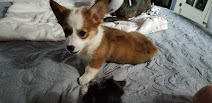Female
Male
During the past 10 years they have fledged 1–3 young per year, first on a telephone pole and now on a new platform and pole installed by Northwestern Energy in 2011. Neither of the adults is banded, but they are thought to be the same pair given their easy habituation to daily ranch activities. If you look carefully, you can probably tell the male from the female by her more heavily streaked chest."
2012 Breeding Details
"This year the pair started incubating around April 23, and two eggs have been confirmed in the nest. Incubation lasts 6–7 weeks, so the first chick should hatch in late May or early June. Young will hatch asynchronously, with the second chick appearing 2–5 days after the first. During years of low food supply, a distinct size difference may develop between the two early on, with the smaller chick usually catching up later. Once the young have hatched, it's another 7–9 weeks until they fledge. Just before the chicks leave the nest, researchers from the University of Montana will band the young and take blood samples as part of a long-term study on mercury in the environment."
"Unique among North American raptors for its diet of live fish and ability to dive into water to catch them, Ospreys are common sights soaring over shorelines, patrolling waterways, and standing on their huge stick nests, white heads gleaming. These large, rangy hawks do well around humans and have rebounded in numbers following the ban on the pesticide DDT. Hunting Ospreys are a picture of concentration, diving with feet outstretched and yellow eyes sighting straight along their talons"























































Asking questions are in fact nice thing if you are not understanding
ReplyDeletesomething entirely, however this piece of
writing provides fastidious understanding even.
Here is my page : Dhtmlcentral